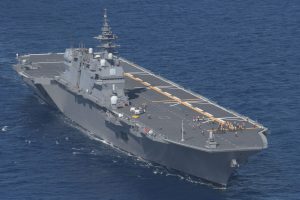On August 30, Japan’s Defense Ministry requested 8.54 trillion yen ($59 billion) for fiscal year 2025 starting in April, its largest ever budget request, as Tokyo ramps up efforts to counter rising military threats posed by China, North Korea, and Russia.
The request, a 7.4 percent increase from the initial budget in the current fiscal year, is the 13th consecutive rise. The trend started when late Prime Minister Abe Shinzo, who adopted a tougher stance against North Korea and China, returned to power in December 2012. Current Prime Minister Kishida Fumio – who like Abe, belongs to the Liberal Democratic Party (LDP) – vowed in 2022 to “fundamentally reinforce Japan’s defense capabilities within the next five years” (i.e. by 2027).
The budget request will be sent to the Finance Ministry to consider before a decision is made in late December. It is almost certain that next year’s budget will be the largest ever, marking the 11th consecutive year of a record-high defense budget.
As in the past two years, the budget plan lists seven key pillars of “necessary efforts to drastically strengthen Japan’s defense capabilities.”
Those are: (1) “stand-off defense capabilities,” such as mass production of longer-range missiles; (2) “comprehensive air and missile defense capabilities” to deal with various missiles; (3) “unmanned asset defense capabilities” such as the use of drones; (4) “cross-domain operational capabilities” in space, cyberspace, and electromagnetic domains; (5) “command and control and intelligence-related functions”; (6) “maneuvering and deployment capability” to send troops and supplies to the front line of a conflict; and (7) “sustainability and resiliency.”
As for the first pillar, the ministry asked for 970 billion yen to develop and produce a range of homegrown stand-off missiles to acquire counterstrike capabilities against enemy bases. That follows through on a decision made in December 2022 for Japan to pursue a long-range strike capability, as reflected in the new National Security Strategy.
Most notably, the Defense Ministry requested 323.2 billion yen to build small satellite constellations to obtain target detection and tracking capabilities essential for striking hostile invasion forces from outside their range.
It also asked for 3 billion yen to acquire a new submarine-launched missile: a long-range cruise missile that can be launched from a submarine’s torpedo tubes. The missile’s development is expected to be completed by Mitsubishi Heavy Industries in fiscal 2027. The Defense Ministry explained that the missile will be installed on the Japan Maritime Self-Defense Force (JMSDF)’s newest Taigei-class submarines.
On the second pillar, the ministry requested 5.379 billion yen for strengthening the nation’s Integrated Air and Missile Defense (IAMD), a system already adopted by the U.S. military, to counteract the increasingly sophisticated airborne threats posed by its hostile neighbors.
On the fourth pillar, the ministry plans to reorganize the current Space Operations Group into a new Space Operations Wing (provisional name), in response to plans to rename the Japan Air Self-Defense Force to the Japan Air and Space Self-Defense Force by fiscal year 2027 to promote preparations to take on missions in the space domain.
On the seventh pillar, the ministry requested 650.2 billion yen to secure ammunition and missiles, such as the middle-range multi-purpose missile, the Type 23 ship-to-air missile, and medium-range air-to-air missiles AIM-120 and AAM-4B. The ministry also had secured 924.9 billion yen for the same purpose in the current fiscal year. Securing ammunition is a crucial lesson Tokyo learned from the Ukraine war.
The ministry’s Acquisition, Technology, and Logistics Agency (ATLA) requested 112.7 billion yen to push ahead with its next-generation fighter program in partnership with the United Kingdom and Italy. It plans to continue developing a basic design for the future fighter’s fuselage and the detailed engineering of its engines.
ATLA also asked for 5.9 billion yen to domestically develop a new medium-range air-to-air guided missile to be installed in the next-generation fighter, which is set to be the successor to the Japan Air Self-Defense Force’s F2 fighter jet.
The JASDF requested 124.9 billion yen to buy eight more Lockheed Martin F-35A Lightning II joint strike fighters and 60.8 billion yen to purchase three more F-35B Lightning multirole fighter aircraft.
The Defense Ministry also asked for 314 billion yen to build three new multirole frigates, called “New FFM” in Tokyo. The new ships are essentially improved Mogami-class multirole frigates of the Japan Maritime Self-Defense Force.
The Defense Ministry also requested 80.8 billion yen as expenses related to the acquisition of two vessels equipped with the Aegis system. Specifically, it made mention of costs associated with preparation for various tests, including demonstration tests.
The vessels are an alternative to previous plans for two land-based Aegis Ashore ballistic missile defense (BMD) systems. That effort was canceled in June 2020 by the Abe administration over concerns that falling components from missile interceptors might hit heavily populated areas in Japan.
The ministry also requested about 1.8 billion yen to continue modifying its Izumo-class helicopter carrier, JS Izumo, into an aircraft carrier capable of enabling Lockheed Martin F-35B fighter aircraft operations. Specifically, it asked for funds to construct the power monitoring and control panel for JS Izumo, which is necessary to complete the ship’s second major modification.
During this fiscal year 2024, as part of its second modification, JS Izumo is undergoing the conversion of the bow section of its flight deck from a trapezoid into a square shape. JS Kaga underwent the same modifications during fiscal year 2023.
The ministry said JS Izumo’s modification is scheduled to be completed in fiscal year 2027, and JS Kaga’s in fiscal year 2028.
Meanwhile, the Japan Ground Self-Defense Force (JGSDF) strives to strengthen security efforts in response to emergency contingencies in areas surrounding Japan, particularly in the Nansei Islands, with China in mind.
It requested 9 billion yen to procure six common tactical wheeled vehicles for reconnaissance and combat for the first time.

































